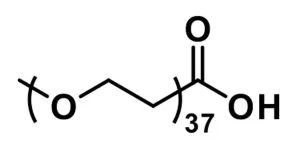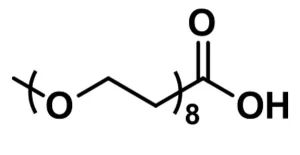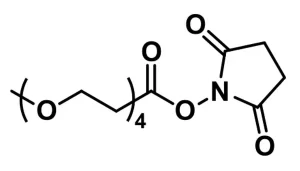m-dPEG®48-NH-CO(CH2)3CO-TFP ester, product number QBD-10143, is a long (151 atoms, 178.5 Å), methyl-terminated, discrete-length polyethylene glycol (dPEG®) spacer. With a reactive end of 2,3,5,6-tetrafluorophenyl (TFP) ester, m-m-dPEG®48-NH-CO(CH2)3CO-TFP ester is designed to modify surfaces containing available free amines.
In aqueous media, free amines react optimally with TFP esters at pH 7.5 – 8.5. Compared to N-hydroxysuccinimidyl (NHS) esters, TFP esters are more hydrolytically stable in water and aqueous buffer. Nevertheless, in aqueous media, the rate at which the ester hydrolyzes to the carboxylic acid increases as the pH rises. Moreover, please note that reacting free amines on biomolecules with this uncharged, methyl-capped dPEG® spacer may alter the overall charge of the resulting conjugates.
Many applications potentially could use m-dPEG®48-NH-CO(CH2)3CO-TFP ester successfully. Among those applications are: cell surface engineering; PK, BD, and immunogenicity profile improvements for biomolecules; imaging applications, by reducing background and non-specific binding and consequently increasing the signal-to-noise ratio; dendrimer construction; nanoparticle, quantum dot, and carbon nanotube surface coating; and, prevention of protein aggregation.
| Unit Size | 100 mg, 1000 mg |
|---|---|
| Molecular Weight | 2407.76; single compound |
| Chemical formula | C₁₀₈H₂₀₃F₄NO₅₁ |
| CAS | N/A |
| Purity | > 97% |
| Spacers | dPEG® Spacer is 151 atoms and 178.5 Å |
| Shipping | Ambient |
| Typical solubility properties (for additional information contact Customer Support) | Methylene Chloride, DMAC, DMSO, DMF or Acetonitrile. |
| Storage and handling | -20°C; Always let come to room temperature before opening; be careful to limit exposure to moisture and restore under an inert atmosphere; stock solutions can be prepared with dry solvent and kept for several days (freeze when not in use). dPEG® pegylation compounds are generally hygroscopic and should be treated as such. This will be less noticeable with liquids, but the solids will become tacky and difficult to manipulate, if care is not taken to minimize air exposure. |
Greg T. Hermanson, Bioconjugate Techniques, 3rd Edition, Elsevier, Waltham, MA 02451, 2013, ISBN 978-0-12-382239-0; See Chapter 18, Discrete PEG Reagents, pp. 787-821, for a full overview of the dPEG® products.
Applicable patents and legal notices are available at legal notices.




Stay in the Loop. Join Our Online Community
Products
Ordering
About Us
Application
Resources

©Vector Laboratories, Inc. 2025 All Rights Reserved.
To provide the best experiences, we use technologies like cookies to store and/or access device information. Consenting to these technologies will allow us to process data such as browsing behavior or unique IDs on this site. Not consenting or withdrawing consent, may adversely affect certain features and functions. Privacy Statement
How do I Request a Quote?
To request a quote for products: